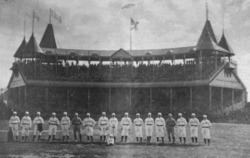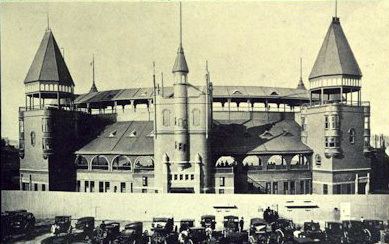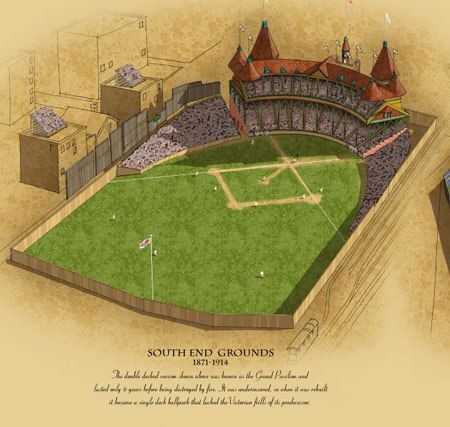Location Boston, Massachusetts Broke ground 1871 Opened 16 May 1871 Owner Atlanta Braves | Surface Grass Closed August 11, 1914 Capacity 6,800 Demolished 1914 | |
 | ||
Field size Left Field – 250 ftLeft-Center – 445 ftDeep Left-Center – 450 ftCenter Field – 440 ftRight-Center – 440 ftRight Field – 255 ft* Dimensions for South End Grounds III Similar Congress Street Grounds, Braves Field, Huntington Avenue Grounds, West Palm Beach Municipal, Palace of the Fans | ||
South End Grounds refers to any one of three baseball parks on one site in Boston, Massachusetts. They were home to the franchise that eventually became known as the Boston Braves, first in the National Association and later in the National League, from 1871 to 1914.
Contents

At least in its third edition, the formal name of the park, as indicated by the sign over its entrance gate, was Boston National League Base Ball Park. It was located on the northeast corner of Columbus Avenue and Walpole Street (now Saint Cyprian's Place), just southwest of the current Carter Playground. Accordingly, it was also known over the years as Walpole Street Grounds; two other names were Union Baseball Grounds and simply Boston Baseball Grounds.

The ballpark was across the New York, New Haven and Hartford Railroad tracks, to the south, from the eventual site of the Huntington Avenue Grounds, home to the Boston American League entry prior to the building of Fenway Park.

The Boston club was initially known as the "Red Stockings", because four of its key players had come from the famous 1869–1870 barnstorming team known as the Cincinnati Red Stockings and took the nickname with them to Boston. Over time the team acquired other informal nicknames, such as "Beaneaters", "Red Caps", "Rustlers" and even "Doves". This team eventually adopted the official nickname "Braves", just a few years before abandoning South End Grounds.

With its tight foul lines and expansive center field, like a scaled-down version of the Polo Grounds, it was sometimes said that the South End had no right or left field, but only a center field.

South End Grounds was rebuilt twice during its lifetime, the first time by choice and the second time by necessity.
South End Grounds (#1)
The first South End Grounds was opened on May 16, 1871. The last game was played on September 10, 1887. The ballpark's stands were demolished later that month to make way for a new structure.
South End Grounds (#2)
The second South End Grounds was opened on May 25, 1888. Sometimes called the "Grand Pavilion", it consisted of a large double-decked grandstand behind home plate and uncovered stands stretching down the right and left field lines, as well as bleachers in right-center field. The medieval-style "witch's cap" turrets were a very popular decoration on public seating structures of the 1880s and 1890s. The ballpark seated 6,800 by one estimate. It was the only double-decked baseball stadium ever built in Boston, apart from the rooftop seating which has turned the single-decked Fenway Park into a de facto double-deck ballpark. The stadium was destroyed in the Great Roxbury Fire of May 15, 1894, which began when children started a small fire beneath the right field bleachers, and which spread and destroyed the stadium and 117 other buildings. During the rebuilding process, the Bostons played their home games at Congress Street Grounds, where they achieved some history in a short time.
South End Grounds (#3)
The third South End Grounds was built in ten weeks on the site of the old stand and opened on July 20, 1894. Because the previous structure had not been sufficiently insured, there wasn't enough money to rebuild the stands according to its old plans, and a smaller structure was built. Few photographs of this ballpark seem to be in circulation. In one sense, the best known photo might be the one showing the opening game of the 1903 World Series, with the Huntington Avenue Grounds in the foreground; and the South End Grounds in the background, its season over, partially hidden by smoke from the rail yards. That image can be seen above this text. On September 12, 1911, 44-year-old legend Cy Young pitched the final home game of his career in a Boston uniform at the grounds against the New York Giants and fellow future Baseball Hall of Famer Christy Mathewson. The Braves moved out of the South End Grounds after their game on August 11, 1914 to accommodate larger crowds during the "stretch drive" of the 1914 pennant race. The team continued to play at Fenway Park until Braves Field was completed during the 1915 season.
Current use
The stadium was demolished after the Braves left. The parking lot between Northeastern University's Columbus Parking Garage and Ruggles Station of the Orange Line of the MBTA now stands on the former site of the grandstand and the infield. The outfield was located where the garage stands. A historical marker commemorating the South End Grounds is located at Ruggles Station.
